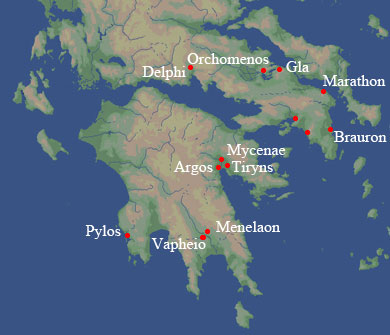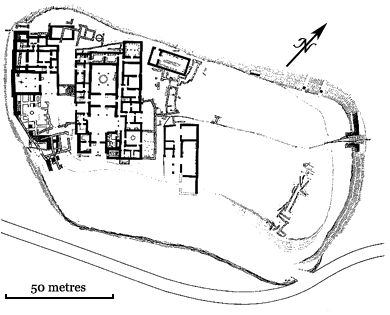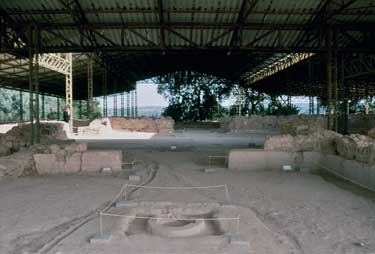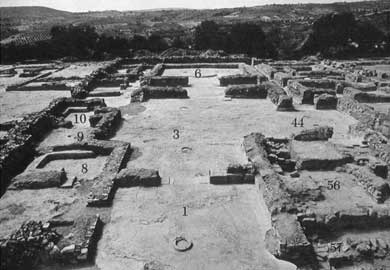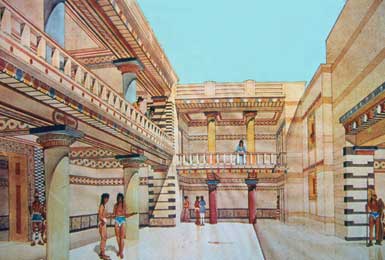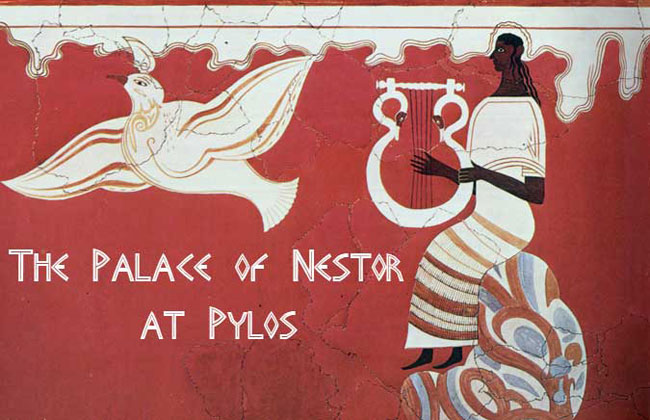
Pylos
According to Homer, Pylos was the home of the hero Nestor, the eldest and wisest of the Greeks who fought at Troy. The site is located on an oblong hill (170 x 90 metres) known as Ano Englianos (“the hill of the Englishman”), overlooking the Bay of Navarino in the southwest Peloponnese. It is nearly 6 kilometres inland but commands clear views of the coastline in both directions. Excavations began in 1939 but were cut short by World War II and the civil war that followed. The principal work was done from 1952-64 by Carl Blegen.
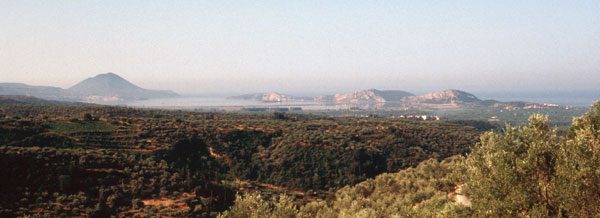
View of the Bay of Navarino from Pylos
Evidence of a Middle Helladic town was found down the slope but all earlier buildings had been removed from the summit prior to the building of the palace during the Late Helladic IIIA period. Although the site evidently lacked the cyclopean masonry found at Tiryns and Mycenae, a gateway was found at the north-eastern end and there are disconnected stretches of masonry suggest some kind of fortifications.
The surviving remains of the palace belong to the Late Helladic IIIB period and consist of four separate buildings— the Main Building; the Southwest Building; a Workshop; and a Wine Magazine.  These apparently replaced earlier (LHIIIA) structures which have almost entirely disappeared.
These apparently replaced earlier (LHIIIA) structures which have almost entirely disappeared.
Most of the surviving walls were built of stone rubble but some trimmed ashlar blocks were used for external facades. Indications are that the walls of the upper storeys were made out of mud brick, a much lighter material. Wood was used to provide a framework for the walls, to frame doors and windows and for the columns to support the ceilings. The walls were regularly plastered— with lime in the important rooms and with clay elsewhere. Floors were paved with a kind of concrete consisting of sand and lime mixed with gravel or broken pottery. In the photograph (above) you can see rubble masonry in the background, a plastered wall in the foreground and the remains of a concrete floor.
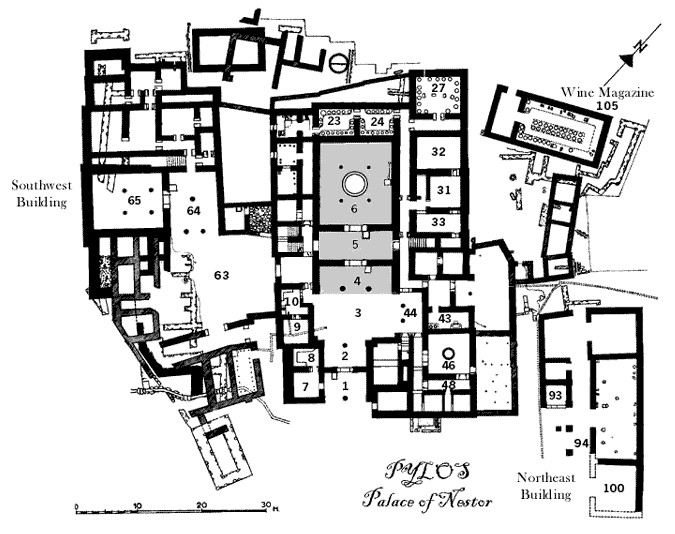
Plan of Nestor's Palace at Pylos
The Main Building measures about 55 x 30 metres with its corners oriented toward the cardinal points. Most of the fine ashlar from the exterior walls has been robbed but some does survive to a height of ca. 80 cm on the north-eastern side. A stretch of tumbled masonry suggests it stood at 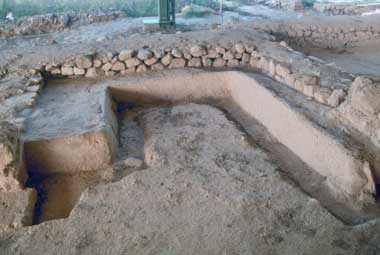 least 3½ metres high while the foundations indicate it was laid out in a series of off-sets. The Propylon (Rooms 1 & 2) was the main entrance to the palace proper and was laid out in the shape of a capital ‘H’ with a porch on either side. To one side of the door was a square emplacement that Blegen, probably rightly, interpreted as a sentry box.
least 3½ metres high while the foundations indicate it was laid out in a series of off-sets. The Propylon (Rooms 1 & 2) was the main entrance to the palace proper and was laid out in the shape of a capital ‘H’ with a porch on either side. To one side of the door was a square emplacement that Blegen, probably rightly, interpreted as a sentry box.
Rooms 7 and 8 (left), to the left of the Propylon, were apparently archive rooms and produced a huge quantity of Linear B tablets. These were filed on shelves or in baskets (300 were found in a large lidded pithos) and dealt principally with receipts and expenditures. The walls of the porches were decorated with murals including a procession of figures (1) along with animals, buildings and seated women (2).
Those whose business took them into the palace proceeded into a modest Forecourt (3), paved with stucco. There was what appears to have been a Waiting Room (10) to the left, lined with  plastered benches and provided with a large pithos on a stand. Since the adjacent Pantry (9) contained over 500 kylikes, the pithos presumably contained wine.
plastered benches and provided with a large pithos on a stand. Since the adjacent Pantry (9) contained over 500 kylikes, the pithos presumably contained wine.
The core of the Palace was a megaron with a large throne room, an ante-chamber and a portico. The Portico (4) was supported by a pair of wooden columns, set on stone bases and contained another sentry box. The Antechamber (5), like the Portico, had a plaster floor divided into squares painted with geometric and curvilinear designs. The walls were decorated frescoes, of which fragments were found, depicting kilted men bearing various objects and robed men and women leading a bull (to slaughter?). Doors at either end of the room gave access to the east and west wings of the Palace, while another in the middle (with a sentry box) led 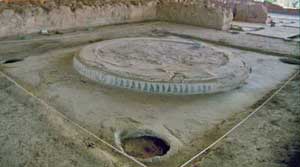 to the Throne Room.
to the Throne Room.
The Throne Room (6) is a spacious hall (ca. 13 x 11 metres) with a large circular hearth (diameter = 4 m.) in the centre (right), surrounded by four columns (perhaps supporting a balcony). The hearth was coated with plaster and was painted with spiral and geometric decoration. In the middle of the right-hand wall was a throne dais next to which were two shallow basins linked by a channel (for libations?). The floor was laid out (somewhat sloppily) in squares with the same sorts of patterns as in the Antechamber—except for the octopus in front of the throne. The walls were painted with griffins and lions behind the throne and a male figure playing a lyre (Orpheus?) in the east corner. The painting is reconstructed in the title image 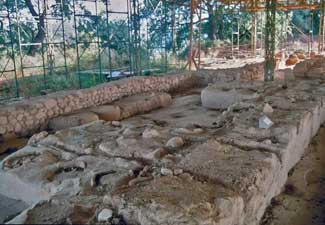 for this page.
for this page.
Two corridors ran on either side of the Throne Room leading to storerooms and pantries in the West Wing and to oil magazines (23, 24 and 27) at the rear of the building (left). The function of the larger rooms (30-34) in the East Wing is unknown. Stairways presumably led to the Domestic Quarters-perhaps Banqueting Halls in the East Wing.
A secondary Megaron (46 and 48) lay in the Eastern Quarter of the complex, entered by a small Portico (44) off the Forecourt— the so-called ‘Queen’s Hall’ (although there is absolutely no evidence to indicate to whom it belonged). The decoration included large-scale lions and griffins but not enough fragments have survived to permit a reconstruction. To the rear of the Queen’s Hall, but not directly linked to it, was a Bathroom (43) with a clay larnax against the wall. A stand with two large jars (for oil or water?) was also found and there were a pair of kylikes in the tub. Presumably, it was here that the “lovely Polycaste who was the youngest of the daughters of Nestor ... had bathed Telemachos” when he came in search of his father, Odysseus.
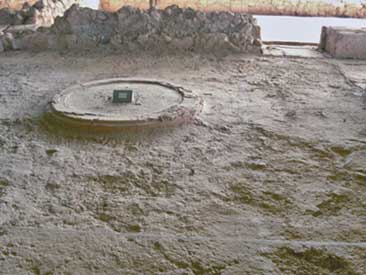
|
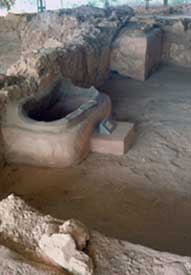
|
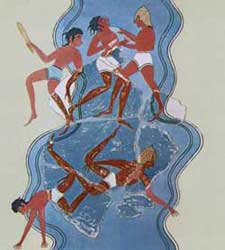 The Southwest Building was badly eroded and disturbed by later buildings but contained many of the features of the Palace. These include an open Courtyard (63), and a Portico leading to a Throne Room (65) but perpendicular to it. The decoration of these rooms included battle scenes, such as the one shown (left) depicting a skirmish at a river crossing, and hunting scenes—a more aristocratic tone. The function of many of the rest of the rooms is not clear although some were certainly storage rooms and pantries.
The Southwest Building was badly eroded and disturbed by later buildings but contained many of the features of the Palace. These include an open Courtyard (63), and a Portico leading to a Throne Room (65) but perpendicular to it. The decoration of these rooms included battle scenes, such as the one shown (left) depicting a skirmish at a river crossing, and hunting scenes—a more aristocratic tone. The function of many of the rest of the rooms is not clear although some were certainly storage rooms and pantries.
The Northeast Building included workshops and certainly functioned as an Armoury— 500 bronze arrowheads where found in Room 100. There is a Portico (94) running for an undetermined distance along the front and a curious room which Blegen believed was a Shrine (93)—a pedestal he believed was an altar stood in front of it.
The Wine Magazine includes Rooms 104 and 105, a single unit lying at the northern corner of the Palace. There were rows of pithoi set in benches and a number of dockets bearing the ideogram for wine.
The Texts from Pylos
The clay tablets found at the palace were all written in the syllabic Linear B script which Michael Ventris demonstrated to be an earlyform of Greek (although some scholars still disagree). Over 1200 have turned up— by far the largest number on the Mainland— the majority from the Archive Room (8). The bulk of the them consist of inventories and lists of commodities. A number name various personnel and mention places nearby. They indicate the presence of a highly organized bureaucracy which kept detailed records of all of the kingdom’s business.
According to the evidence of the texts, social organization at Pylos was clearly hierarchical. At the head of it was the wanaka,(‘king’) whowas also the largest landholder. Under him was theraweketa (‘leader of the people’) who also owned extensive estates but whose role seems mainly religious. They stood at the head of a landed aristocracy known as the eqeta (‘followers’). These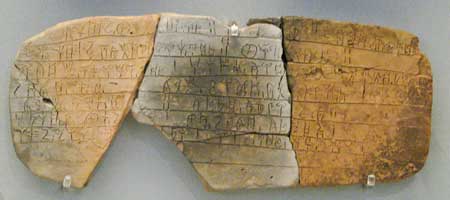 men possessed estates, wore a distinctive type of dress, owned chariots and presumably provided the officer class of the army.
men possessed estates, wore a distinctive type of dress, owned chariots and presumably provided the officer class of the army.
The kingdom was divided into two provinces, one ruled from Pu-ro (Pylos) and the other from Re-u-ko-to-ro (location unknown). Each of these was divided into a number of districts (16 are known) with its own governor(?)— korete. These were required to contribute supplies of certain raw materials to the capital-only 2 of the 6 (ox hides and woollen cloth) have been identified. The local gentry were known as the tereta but there are numerous references to craftsmen of various types. Bronze smiths were accorded special status and were exempt from certain taxes. There are a number of references to the damos (‘people) who apparently held land in common. Slavery certainly existed as an institution and there are frequent references to female workers, especially weavers. Many apparently came from the Eastern Aegean and were presumably prizes of war (the fate of the Trojan Women was similar). A number of the korete also held religious offices— apparently these were open to women as well as men.
The most important document is a long list of gifts sent to a number of gods and goddesses and to various sanctuaries. The gods include such well known Greek gods as Zeus, Hermes and Dionysos but the principal god seems to have been Poseidon. The goddesses apparently include Hera and Artemis but the term Potnija— the ‘Lady’ of such-and-such a place— is most common. Gifts to the gods included gold vessels and ‘slaves’ both male and female. It may have been considered an honour to serve the deity in that capacity. Two sanctuaries seem particularly important— one to Poseidon (Po-se-da-on-e) in Pylos and another known as Pakijane, belonging to an unnamed goddess.

